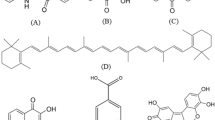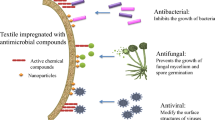Abstract
The present work reports the application of trisiloxane polyether silicone surfactant to remove various stains along with a range of hydrocarbon (organic) surfactants to investigate whether silicone surfactants offer synergism or antagonism during the cotton fabric cleaning process. Cotton fabric was soiled with red wine, turmeric, permanent marker, acrylic paint, and coffee and washed with the original fabric in aqueous solutions of individual surfactant and blend of surfactants by applying the conventional shaking washing method. The detergency and soil redeposition were determined from the alteration in the surface reflectance of prepared stained fabrics and the original fabric after washing. Surfactants used for the washing were trisiloxane polyether silicone surfactant (AG-Platinum), sodium dodecyl benzene sulfonate, lauryl alcohol ethoxylate (LA-10), and nonylphenol ethoxylate (NP-10) and their blends. In comparison with individual hydrocarbon surfactants, blends of surfactants (with different hydrocarbon to silicone surfactant ratios) dislodged stains (accumulated on the fabric as a result of staining) effectively at shorter time and at lower bath ratio because of superior surface properties. With increasing concentration of surfactant, detergency increased and reached a maximum at the critical micelle concentration (CMC). Silicone surfactant reduced the CMCs of the surfactant blends and provided better detergency at lower concentration. From this study, it was found that silicone surfactant could be successfully introduced into laundry detergent formulations.
Graphical abstract












Similar content being viewed by others
References
Lin L-H, Wang C-C, Chen K-M, Lin P-C. Synthesis and physicochemical properties of silicon-based gemini surfactants. Coll Surf Physicochem Eng Asp. 2013;436:881–9. doi:10.1016/j.colsurfa.2013.08.036.
Lee SA, Oh SH, Lee W. The effect of direct fluorination of polydimethylsiloxane films on their surface properties. J Colloid Interface Sci. 2009;332:461–6. doi:10.1016/j.jcis.2008.12.062.
Hill RM. Silicone surfactants—new developments. Curr Opin Colloid Interface Sci. 2002;7:255–61.
Jia W, Rao X, Song Z, Shang S. Microwave-assisted synthesis and properties of a novel cationic gemini surfactant with the hydrophenanthrene structure. J Surfactants Deterg. 2009;12:261–7. doi:10.1007/s11743-009-1120-z.
Lin L-H, Lai Y-C. Synthesis and physicochemical properties of nonionic Gemini surfactants with a sulfonate spacer. Colloids Surf Physicochem Eng Asp. 2011;386:65–70. doi:10.1016/j.colsurfa.2011.06.031.
Yoshimura T, Bong M, Matsuoka K, Honda C, Endo K. Surface properties and aggregate morphology of partially fluorinated carboxylate-type anionic gemini surfactants. J Colloid Interface Sci. 2009;339:230–5. doi:10.1016/j.jcis.2009.07.054.
Liu H-J, Lin L-H, Chen K-M. Preparation and properties of water-soluble polyester surfactants. III. Preparation and wetting properties of polyethylene glycol-polydimethylsiloxane polyester surfactants. J Appl Polym Sci. 2003;88:1236–41. doi:10.1002/app.11793.
Man VF. Detergent compositions for the removal of complex organic or greasy soils. 2003. http://www.google.com/patents/US6506261. Accessed 3 Feb 2016.
Murphy DS. Prewash stain remover composition with siloxane based surfactant. 2000. http://www.google.com/patents/US6077317. Accessed 3 Feb 2016.
Murphy PM, Dittman MD. Process for cleaning turmeric stains. 2001. http://www.google.com/patents/US6300299. Accessed 3 Feb 2016.
Del Duca V, Esposito A, Leone M. Liquid bleaching composition comprising a bleach and a substantially linear nonionic surfactant, whereby said substantially linear nonionic surfactant has the general formula: R-(A) x-(B) y-(C) zO-R1 wherein: R is an even numbered. 2003. http://www.google.com/patents/US6620774. Accessed 4 Feb 2016.
Thirunavukarasu K, Edwinoliver NG, Durai Anbarasan S, Gowthaman MK, Iefuji H, Kamini NR. Removal of triglyceride soil from fabrics by a novel lipase from Cryptococcus sp. S-2. Process Biochem. 2008;43:701–6. doi:10.1016/j.procbio.2008.02.011.
Muir AC, McKeown P, Li Y, Kobine JJ, Bird MR. The removal of food fat based soils during the washing of fabrics. Chem Eng Res Des. 2013;91:1602–13. doi:10.1016/j.cherd.2013.03.004.
de Castro TC, Taylor MC, Kieser JA, Carr DJ, Duncan W. Systematic investigation of drip stains on apparel fabrics: the effects of prior-laundering, fibre content and fabric structure on final stain appearance. Forensic Sci Int. 2015;250:98–109. doi:10.1016/j.forsciint.2015.03.004.
Gotoh K, Harayama K. Application of ultrasound to textiles washing in aqueous solutions. Ultrason Sonochem. 2013;20:747–53. doi:10.1016/j.ultsonch.2012.10.001.
Zhou T, Yang H, Xu X, Wang X, Wang J, Dong G. Synthesis, surface and aggregation properties of nonionic poly(ethylene oxide) gemini surfactants. Colloids Surf Physicochem Eng Asp. 2008;317:339–43. doi:10.1016/j.colsurfa.2007.11.008.
Wang Y, Han Y, Huang X, Cao M, Wang Y. Aggregation behaviors of a series of anionic sulfonate gemini surfactants and their corresponding monomeric surfactant. J Colloid Interface Sci. 2008;319:534–41. doi:10.1016/j.jcis.2007.11.021.
Gentle TE, Snow SA. Absorption of small silicone polyether surfactants at the air/water surface. Langmuir. 1995;11:2905–10. doi:10.1021/la00008a011.
Kanner B, Reid WG, Petersen IH. Synthesis and properties of siloxane-polyether copolymer surfactants. IEC Prod Res Dev. 1967;6:88–92. doi:10.1021/i360022a002.
Sainath K, Ghosh P. Stabilization of silicone oil-in-water emulsions by ionic surfactant and electrolytes: the role of adsorption and electric charge at the interface. Ind Eng Chem Res. 2013;52:15808–16. doi:10.1021/ie401490c.
Acknowledgements
We would like to express sincere gratitude towards Elkay Chemicals Pvt. Ltd., Pune (India) for providing the necessary financial assistance to conduct this research work.
Author information
Authors and Affiliations
Corresponding author
About this article
Cite this article
Pukale, D.D., Bansode, A.S., Pinjari, D.V. et al. Application of Silicone Surfactant Along with Hydrocarbon Surfactants to Textile Washing for the Removal of Different Complex Stains. J Surfact Deterg 20, 287–295 (2017). https://doi.org/10.1007/s11743-016-1901-0
Received:
Accepted:
Published:
Issue Date:
DOI: https://doi.org/10.1007/s11743-016-1901-0




